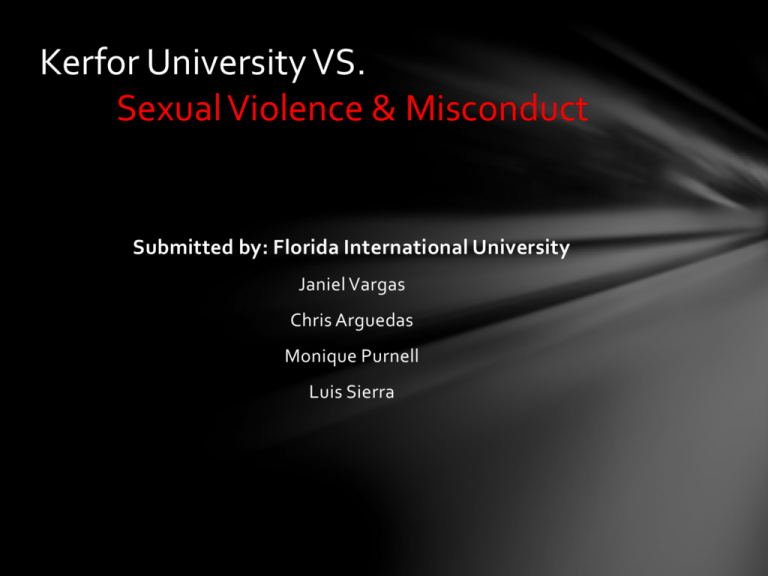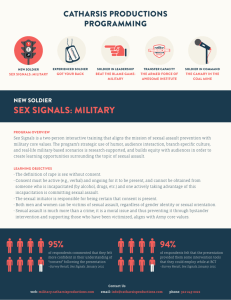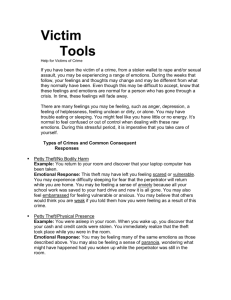
Kerfor University VS.
Sexual Violence & Misconduct
Submitted by: Florida International University
Janiel Vargas
Chris Arguedas
Monique Purnell
Luis Sierra
2014 Taskforce Objectives
1.
To spread knowledge surrounding sexual violence & sexual assault to KU’s
campus community through educational programming and transparent
initiatives
2.
Distribute sexual assault resources to the campus community to ensure the
safety of its students, faculty, and staff
3.
To produce procedures grounded in the SaVE Act
4.
To better serve our student’s, specifically victim’s of sexual assault and
violence
5.
To ensure the rights of the victim as well as those accused
Outline:
Part One:
• Raising Awareness
Part Two:
• Programmatic Efforts
Part Three:
• Ensuring the Rights of the Victim and the Accused
Part Four:
• What is Consent?
Part Five:
• Relevant Theory
Setting Boundaries
At Kerfor U
Sexual Misconduct serves as an overarching issue that we as a taskforce aim
to confront and alleviate. It can be defined as:
Sexual Assault: General term that includes any forced or unwanted sexual
activity, including rape, incest, sexual abuse, and molestation
• Forced or unwanted touching of an intimate part of the body, such as
breasts, buttocks, or genitals
Rape: A specific type of sexual assault which involves any forced,
manipulated, or coerced penetration of the vagina, anus, or mouth, by a
penis or other object
Other forms of Sexual Misconduct: Sexual harassment, intimate partner
violence, stalking, voyeurism, and any other conduct of a sexual nature that
is nonconsensual, or has the purpose or effect of threatening, intimidating,
or coercing a person. (http://smr.yale.edu/definitions-sexual-misconduct-consent-and-harassment)
Part One:
Raising Awareness
• In 2010 there were 188,380 reports of rape and/or sexual assault in the
United States.
• More than half of rape and sexual assault crimes take place between
6pm and 6am.
• Females are more likely to be victims of rape or sexual assault
(182,000) than males (40,000).
•
Most victims of rape or sexual assault are females younger than 24 years of age.
• Most rapes committed against women are committed by an intimate
partner (spouse, boyfriend/girlfriend) or someone else they know
(friend, family member, acquaintance). (From Bureau of Justice Statistics, Criminal
Victimization, 2010, National Crime Victimization Survey: http://www.bjs.gov/content/pub/pdf/cv10.pdf)
Raising Awareness:
Ponder before you post
Questions the taskforce would like student’s to ask themselves surrounding
phone applications and text messages:
1. Would I want my parent, best friend, sibling, supervisor, or professor to view
this photo?
2. Is the photo an accurate depiction of my character?
3. Could this photo prevent me from finding a job in the future?
4. Would you want the photo posted to a website for the world to see?
Something to share with students:
Snapchat’s Policy States:
We also cannot prevent others from making copies of your Snaps (e.g., by taking a screenshot). If we are
able to detect that the recipient has captured a screenshot of a Snap that you send, we will attempt to
notify you. In addition, as for any other digital information, there may be ways to access Snaps while still
in temporary storage on recipients’ devices or, forensically, even after they are deleted. You should not
use Snapchat to send messages if you want to be certain that the recipient cannot keep a copy.
Raising Awareness
Incorporating Social Media
#keepitsafe is the taskforce’s social media campaign geared towards
changing the paradigm of sexual assault from “we must protect ourselves”
to “let’s protect each other”. More importantly, the campaign hopes to
integrate accountability into the lives of students through mutual respect
and support.
• The #keepitsafe campaign is intended for Instagram where student’s are
encouraged to make the #keepitsafe pledge:
•
I pledge to familiarize myself with the SaVE act and how it applies to my campus
community.
•
I pledge to educate myself on sexual misconduct.
•
I pledge to protect my peers through sexual misconduct prevention.
Part Two:
Programmatic Efforts
• The KU taskforce would like to institute a “Sexual Assault Awareness
Month’’ during the month of April by implementing the following action
steps:
•
On April 1st students, faculty, and staff are encouraged to wear purple for Victim
Advocacy.
•
The Division of Student Affairs will also sell purple ribbons that read #keepitsafe to
promote the campaign and support Victim Advocacy on campus.
•
All proceeds will benefit a local healthcare clinic that conducts free STD screenings
for voluntary donations.
Programs continued:
The House of Repression
This program will allow for students to walk through a series of staged
sexual assault scenarios and encounter the following:
•
Walls lined with information aimed at debunking myths surrounding
sexual assault
• 3 staged “sexual assault” scenarios led by student actors
•
Each scenario will present a different hypothetical situation that can occur on a
college campus.
• A self reflection room, facilitated by student actors, will provide students
with the opportunity to recount how the performances made them feel
and what they learned from the experience.
• Last but not least, students are encouraged to pledge to #keepitsafe at
KU and post their pledge to Instagram.
Anti-Myths:
Examples of information shared on the walls of the “House of Repression”:
• Most rapists are strangers.
•
77% of female sexual assault victims know their assailants. On college campuses, 9
out of 10 female victims know their attackers.
• If victims don't aggressively fight back, they weren't raped.
•
Intentional sexual contact without consent of the other person constitutes sexual
assault, regardless of whether or not victims fight back. Victims may not use
physical force for a number of reasons, including fear or physical incapacitation.
• Men cannot be raped.
•
1 out of 33 men will be a victim of rape or sexual assault in his lifetime.
(http://www.dosomething.org/tipsandtools/11-myths-about-sexual-assault-and-dating-violence#)
A student’s testimonial:
The House of Repression
Part Three:
Ensuring the Rights
The Accused
As a public university our taskforce will:
• Provide Equal Protection and Due Process in judicial hearings to
those who were accused of having committed sexual violence.
• The accused must be made aware of what type of sexual violence
he or she is being charged with by the victim.
• Moreover, the SaVE Act clearly states the following which we
intend to adhere to:
•
Both parties can have representatives present during hearing.
•
Both parties have the right to receive written outcomes.
Ensuring the Rights
The Victims
Our taskforce will execute the following:
• Foster a relationship with Counseling & Psychological Services to better
accommodate victims of sexual violence & misconduct.
• Establish a 24/7 Assault Hotline, in conjunction with the University Police
Department, where victims can report sexual misconduct and find
resources.
• Establish a Peer Ear Program that allows for victims to talk through
situations with fellow peers who have experienced and overcome sexual
assault.
Victim Support Services
To ensure the safety of victims, Kerfor U plans to provide
accommodations to separate the victim from the assaulter and
successfully reorient them to campus after their attack:
•
Academic support
•
•
Ensuring that victims and their assaulter don’t share classes
Teacher’s must be kept in the loop (if warranted and with the full consent of the student)
•
Housing accommodations (in the event they live in the same resident
hall as the perpetrator)
•
Free health screening & STD tests on campus
•
Maintaining relationship between campus police in processing and
accommodating assault cases
Part Four:
“What is consent?”
• Consent means that both people in a sexual encounter must agree to it, and
either person may decide at any time that they no longer consent and want to
stop the activity.
• Consenting to one behavior does not obligate you to consent to any other
behaviors.
•
One occasion also does not obligate you to consent on any other occasion.
• Consenting means only that at this particular time, you would like to engage
in this particular sexual behavior.
• Certain circumstances make it impossible for a person to legally give consent.
•
Ex: If someone is drunk or high on drugs, then that person cannot give consent.
• Age can also determine whether a person can legally consent to certain
sexual behaviors, such as intercourse, oral sex, or anal sex.
(http://www.pamf.org/teen/abc/sex/consent.html)
Part Five:
Schlossberg's Transition Theory
Victims of sexual misconduct undergo a period of transitions from when the
act is committed, to how it’s dealt with, and to when they’ve recovered
from the traumatizing experience, at which point they’ll be able to resume
some semblance of normalcy in their everyday life.
As such, we have included the phases of transitions that a victim of sexual
misconduct would traverse through (The 4 S’s):
• Situation
• Self
• Support
• Strategies
Schlossberg's Transition Theory
Continued
• Situation: In this phase what triggers the sexual act and its timing greatly
impacts how the victim controls what occurs.
• Self: In this phase the sexual act impacts how the victim copes with it and
on how he or she views life and those with whom they interact with on a
daily basis.
• Support: In this phase the victim seeks console from friends, family
members, and other relatives in order to not feel alone during such a
vulnerable time in their life.
• Strategies: In this phase the victim searches for resolutions whether
they’d be in the form of interventions or otherwise which will help him or
her get the healing process underway.
References:
Campus Sexual Violence Resource List. (2013, January 1). Retrieved February 16, 2014, from Sexual
Assault Awareness Month: http://www.nsvrc.org/saam/campus-resource-list
Evans, N. J., Forney, D. S., Guido, F. M., Patton, L. D., & Renn, K. A. (2010). College Student Development
Theory. (1st ed., Vol. 1st, p. 359). San Francisco, California: Jossey-Bass. DOI: www.joseeybass.com
Rape & Sexual Assault. (2010, January 1). Retrieved February 18, 2014, from Safe Horizon:
http://www.safehorizon.org/index/what-we-do-2/rape--sexual-assault64.html?gclid=CMnS0Lbc0bwCFeJF7Aod30wAng
Sexual Violence: Definitions. (2014, January 2). Retrieved February 16, 2014, from Centers for Disease
Control and Prevention: http://www.cdc.gov/violenceprevention/sexualviolence/definitions.html
The Campus Sexual Violence Elimination (SaVE) Act . (2014, January 31). Retrieved February 12, 2014,
from Clery Center for Security on Campus: http://clerycenter.org/campus-sexual-violence-eliminationsave-act
Title IX Education Amendments of 1972. (2014, January 1). Retrieved February 12, 2014, from United
States Department of Labor: http://www.dol.gov/oasam/regs/statutes/titleix.htm
VAWA Amendments to Clery/Campus SaVE . (2014, January 31). Retrieved February 12, 2014, from Clery
Center for Security on Campus: http://clerycenter.org/article/vawa-amendments-clerycampus-save
VAWA Reauthorization. (2014, January 31). Retrieved February 15, 2014, from Clery Center For Security
on Campus: http://clerycenter.org/article/vawa-reauthorization
William A., K., & Barbara E., L. (2007). The Law of Higher Education. (1st ed., Vol. 1st, p. 665). San
Francisco, California: Jossey-Bass. DOI: www.josseybass.com



